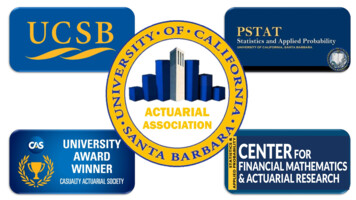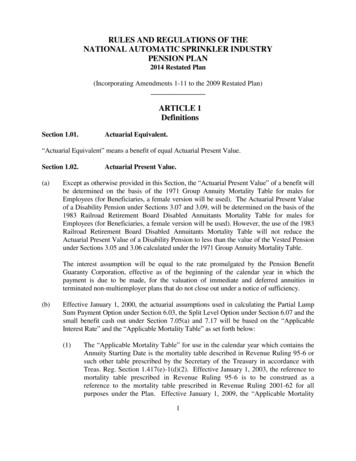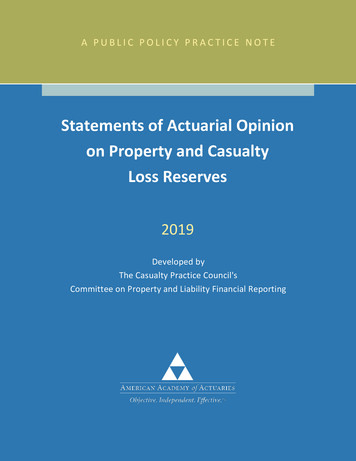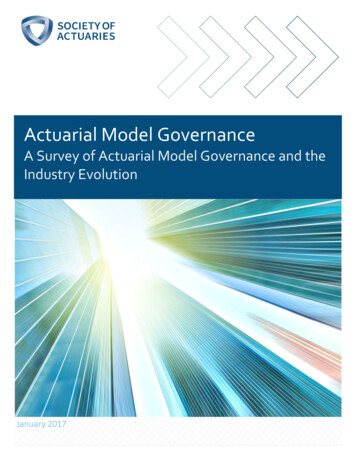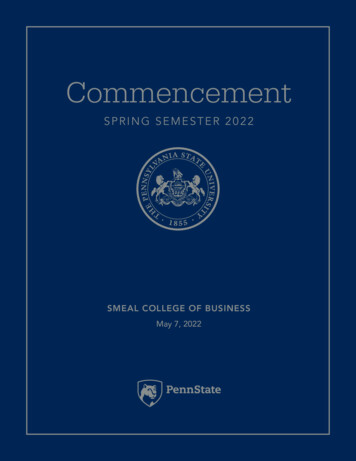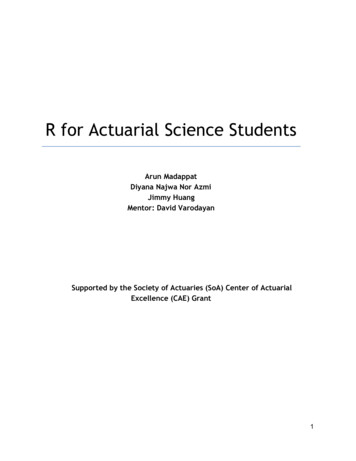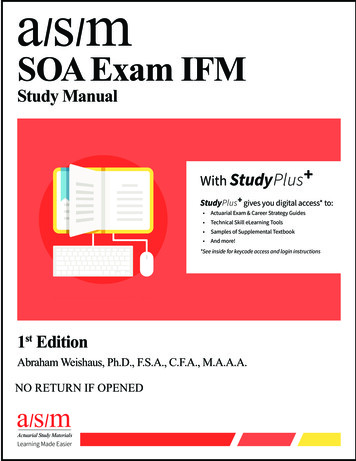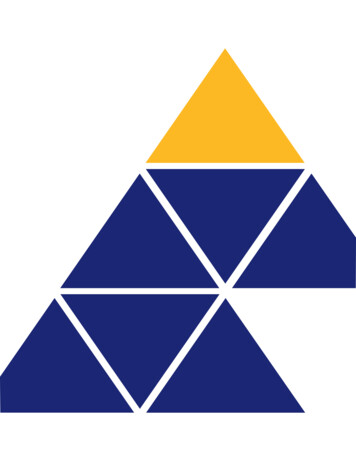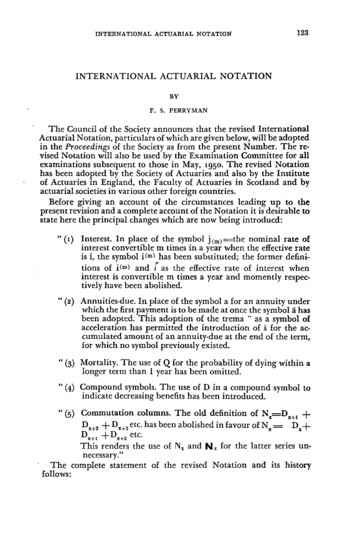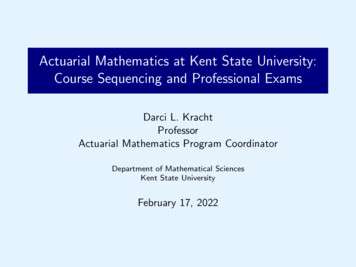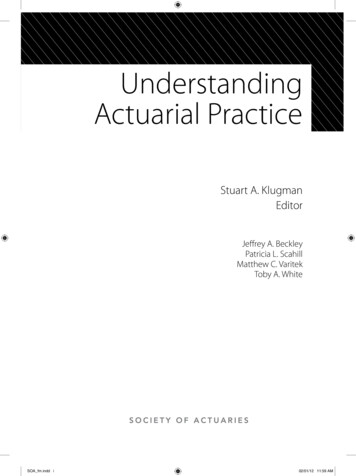
Transcription
UnderstandingActuarial PracticeStuart A. KlugmanEditorJeffrey A. BeckleyPatricia L. ScahillMatthew C. VaritekToby A. WhiteSOA fm.indd i02/01/12 11:59 AM
Copyright 2012. Society of Actuaries. All rights reserved under U.S. and international laws.No part of this publication may be reproduced or distributed in any form without the expresswritten permission of the Society of Actuaries.This publication is provided for informational and educational purposes only. The Society ofActuaries makes no representation or guarantee with regard to its content, and disclaims anyresponsibility or liability in connection with the use or misuse of any information providedherein. This publication should not be construed as professional or financial advice. Statements of fact and opinions expressed herein are those of the individual author and are notnecessarily those of the Society of Actuaries or its officers, directors, staff or representatives.The Society of Actuaries does not endorse or make any guarantee with regard to any products, services or procedures mentioned or advertised herein.Library of Congress Cataloging-in-Publication DataUnderstanding actuarial practice / Stuart A. Klugman, editor.p. cm.ISBN 978-0-9759337-5-6 (alk. paper)1. Actuarial science. I. Klugman, Stuart A., 1949–HG8781.U495 2013368’.01—dc232011050636ISBN 978-0-9759337-5-6First EditionPrinted in the United States of America16 15 14 13 12SOA fm.indd ii1 2 3 4 502/01/12 11:59 AM
ContentsPART 1: INTRODUCTION11Introduction1.1Purpose of This Textbook1.2Prerequisites1.3How to Use This Textbook1.4Actuarial Work and the Actuarial Profession2Actuarial Science and the Actuarial Profession 72.1A Brief History of Actuarial Science and the Actuarial Profession2.2What Actuaries Do and What Sets Them Apart 92.3Financial Security Systems2.4Insurance Industry Overview 232.5Actuarial Areas of Practice 262.6Key Competencies for Actuaries3The Actuarial Control Cycle 393.1Introduction3.2Versions and Evolution of the Actuarial Control Cycle3.3An Expanded Discussion of the Control Cycle 453.4Control Cycle Examples 473.5Some Conclusions about Actuarial Work and the Control Cycle4Principles of Actuarial Science 53335567133439PART 2: INVESTMENTS4051555Introduction and External Factors 575.1Overview of Investments Section 575.2External Factors Affecting Investment Decisions57iiiSOA fm.indd iii02/01/12 11:59 AM
ivContents6Interest Theory 656.1Types of Interest Rates6.2Two Approaches to Interest 696.3Capital Budgeting6.4Annuities 757Asset Types7.1Underlying Assets7.2Derivatives7.3Assets Used in Insurance Company Portfolios 1008Investing/Portfolio Management 1038.1Introductory Investment Issues 1038.2Mean-Variance Analysis8.3Other Issues9Finance Models and Data9.1Capital Asset Pricing Model9.2Other Financial Modeling Frameworks9.3Data and Estimation 1331071858592107113121121126The Term Structure of Interest Rates 13910.1 Interest Rates10.2 Yield Curves1165139143Asset and Liability Management11.1 Interest Rate Sensitivity15115111.2 Immunization 15911.3 More on Asset and Liability Matching16211.4 Asset and Liability Management Risk Measures for Life InsuranceCompanies 164SOA fm.indd iv02/01/12 11:59 AM
ContentsPART 3: LIFE INSURANCE AND ANNUITIES1213Introductionv169171Types of Coverage17313.1 Life Insurance 17313.2 Annuities 21314External Forces and Life and Annuity Products 23114.1 Cultural and Social Factors 23114.2 Demographic Trends23214.3 Economic and Business Environment 23514.4 Government Influences15Pricing24115.1 Measuring Profitability15.2 Profit Measures16236241244Profit Testing 25316.1 Approaches to Profit Testing16.2 Pricing Tools26116.3 Asset Shares26116.4 Analysis of Book Profits16.5 Sources of Profit26728016.6 Company Models17253282Inputs for Profit Testing 28917.1 Investment Income 28917.2 Equity Returns17.3 Mortality17.4 Persistency17.5 ExpensesSOA fm.indd v28929029029102/01/12 11:59 AM
viContents18Regulatory Influences on Profit Testing18.1 Reserves29518.2 Reserve Model29818.3 Nonforfeiture Requirements18.4 Income Taxes1932133118.5 Required Surplus18.6 Premiums295331332Monitoring Results 33719.1 Why Monitor Experience 33719.2 What to Monitor 33720Closing 341PART 4: RETIREMENT BENEFITS21343Introduction to Retirement Plans 34521.1 External Forces Underlying the Need for a Retirement Income System34521.2 History of Retirement Plans 35522Overview of Retirement Financial Security Systems 35922.1 Most Common Types of Formal Retirement Plans35922.2 Government-Sponsored Social Security Systems36222.3 Employer-Sponsored Retirement Programs 37522.4 Tax Structure of U.S. Employer-Sponsored Pensions 37622.5 The Role of the Courts in Retirement Plans38222.6 Canadian Employer-Sponsored Pensions 38322.7 U.K. Pension System38522.8 Mexican Pension System38622.9 The Actuary’s Role in Employer-Sponsored Defined Benefit Pensions38622.10 Advantages of Having Retirement Income from Multiple Sources 38723Retirement Plan Design 38923.1 Defined Benefit and Defined Contribution Plans 38923.2 Hybrid Plan DesignSOA fm.indd vi39402/01/12 11:59 AM
Contentsvii23.3 Allocation of Risks in Retirement Plans 39623.4 U.S. Pension Plan Design40023.5 Canadian Pension Plan Design40323.6 Using Retirement Plans to Manage an Employer’s Workforce24404Funding for Employer-Sponsored Retirement Plans40724.1 Overview of Employer-Sponsored Defined Benefit Plan Funding 40724.2 Actuarial Assumptions Used in Defined Benefit Plan Valuations 41024.3 Terminology Commonly Used in Pension Funding24.4 Funding Methods41141224.5 Asset and Participant Data Needed for the Actuarial Valuation 41524.6 Selecting the Amount to Fund 41724.7 Actuarial Valuation—Stakeholders and their Views 41825Pension Accounting in the United States 41925.1 Policy Reason for U.S. Pension Accounting Requirements41925.2 Pension Accounting Requirements 42025.3 Inputs into Pension Accounting Calculations 42025.4 Responsibility for Company Financial Statements 42125.5 Pension Expense25.6 Pension Disclosure26421422Modeling Actuarial Costs and Expense26.1 Actuarial Forecast Modeling System42542526.2 Uses of Actuarial Forecast Modeling for Retirement Plans27Retirement Plan Solvency427PART 5: GROUP AND HEALTH INSURANCE28425429Introduction to Group Insurance 43128.1 Principles of Insurable Groups 43128.2 Buyers of Group Insurance Products 43128.3 Sellers of Group Insurance Products 434SOA fm.indd vii02/01/12 11:59 AM
viiiContents28.4 Overview of Health Economics 43728.5 Key Influences on Health Care Funding Models44328.6 Overview of Disability Insurance 44528.7 Overview of Long-Term Care Insurance44628.8 Overview of Group Life Insurance 44729External Factors 44929.1 Forces Driving the Need for Benefit Plans 44929.2 Cultural and Social Values 45029.3 Demographics45129.4 Impact of Policy and Regulation30452Pricing for Group Benefit Plans 45730.1 Data and Assumptions 45730.2 Network Management and Plan Design45930.3 Estimating Claims Costs 45930.4 Projecting Costs to the Rating Period30.5 Calculating Benefit Factors46930.6 Impact of Benefit Changes47246630.7 Calculating Manual Gross Premiums 47330.8 Experience Rating31Reserving47748731.1 Definitions of Terms48731.2 Short-Term Reserves 49031.3 Long-Term Reserves49831.4 Evaluating Claim Reserve Adequacy50331.5 Guidelines and Practice Standards for ReservesBibilography504505Index 509SOA fm.indd viii02/01/12 11:59 AM
PrefaceA critical point in an actuary’s education is the transition from understanding the mathematical underpinnings of actuarial science to putting them into practice. The problems becomeless well-defined and the solutions less clear-cut. This is not only a challenge for candidateswho are making the transition but also a challenge for those who are guiding their learning and assessing their performance. In 2003 the Society of Actuaries Board of Governorstook the inspired step of moving a candidate’s education in this transition from a self-studyreading of textbooks followed by a proctored exam to delivery of the candidate’s educationthrough a supported e-Learning environment. Starting in 2006, candidates for the ASA designation began taking the Fundamentals of Actuarial Practice Course (FAP).The FAP Course brought several new features to the education and assessment process.Among them were: Self-paced learning through online modules. The modules were designed to guidecandidates through the material. This would be done through readings (both onlineand offline), review questions, case studies, activities, and exercises. Rather than organize the course by function or practice area, the course wasorganized around the control cycle. This is a framework for problem solving anddecision making that begins with defining the problem, continues with designingthe solution and concludes with monitoring the results. Candidates are made awarethat external forces affect the process and that the work must be completed in aprofessional manner. Formal assessments evolved to become take-home open book problems that oftenrequired making judgments and recommendations to be communicated to theintended audiences, usually in the form of memos.Fortunately, a suitable text was available (Bellis, et. al., 2003) covering the application of thecontrol cycle to solving actuarial problems. In order to supplement the overview providedby this text, course candidates were asked to purchase several additional texts covering riskmanagement, property and casualty insurance, investments, retirement benefits, health insurance, and life insurance and annuities. Because these texts were written for other purposes,disjoint sections of each text were used for FAP. This was both inconvenient and expensive forcandidates. In 2010 a project was undertaken to create a text that would be purpose-writtenfor FAP candidates with coverage of finance, life insurance and annuities, retirement benefitsand health insurance.Four authors with extensive experience were recruited to write the sections. Biographicalinformation about each appears elsewhere in this book. They were asked to ensure that all theinformation on their subject that is covered in FAP appears in their section. However, whilethe FAP Course makes reference to readings in this text, the text itself does not referenceother aspects of the FAP Course. Thus, this text also provides a stand-alone introduction toactuarial practice in each area.ixSOA fm.indd ix02/01/12 11:59 AM
xPrefaceThe text begins with an introductory section that has a brief review of the actuarial profession, some comments on what it means to be a professional and a discussion of the Actuarial Control Cycle. It is designed to provide context for FAP candidates and for the rest ofthis book. Each of the four practice area sections of this book are self-contained and can bestudied in any order. FAP candidates will skip from some parts of this book to others as theirstudy in FAP is organized by the Actuarial Control Cycle and not by practice area.As you read this book there will be references to “online resources.” There is a dedicatedwebpage for this text. At it, you can download additional readings, spreadsheets that supportvarious examples and exercises, and solutions to the book’s exercises. These resources can befound at www.soa.org/FAP.To both FAP candidates and those who want an introduction to how actuarial science is practiced in the four areas covered, I hope this book is both illuminating and enjoyable.Stuart Klugman, FSA, CERAJanuary 2012SOA fm.indd x02/01/12 11:59 AM
AcknowledgmentsMany people contributed to the production of this book. Guidance throughout was provided by the Society of Actuaries’ (SOA) e-Learning leaders, in particular, Steve Eadie, thee-Learning Chair and Jill Carpenter, the Fundamentals of Actuarial Practice (FAP) Curriculum General Officer. Several people reviewed drafts of the various sections, includingJill Carpenter, Kathy Eadie, Steve Eadie, Andrew Gillies, Juan Herrera, Warren Luckner,Kory Olsen, Marcus Robertson, Brett Roush, and Heather Waldron. Jules Gribble contributed a version of the control cycle that appears in Chapter 3. Ken Westover and SheldonSelby assisted with the material on the Canadian Asset Liability Method in Chapter 18. KarenPerry, the SOA’s Publications Manager coordinated all the work of turning our manuscriptinto a published text. She ensured that everything kept to schedule so that we would have thisbook ready in time for the January 2012 roll out of the revised FAP Course. I also want tothank the four authors who wrote most of the content. Producing high-quality work on tightdeadlines is not easy, but they rose to the challenge. —Stuart KlugmanMy thanks go to my wife Jean for her patience during the writing of the Life and AnnuitySection. Also, I want to thank James Christou, Michael Kavanagh, and Chris Fievoli for helpwith the Canadian material. Finally, Stuart Klugman was a tireless reviewer which greatlyimproved my section. —Jeffrey BeckleyI am grateful for the encouragement and understanding I received from my husband, GaryLarreategui, and Nyhart’s CEO, Tom Totten, as I juggled priorities while working on theRetirement Plans section. Stuart Klugman was an excellent reviewer of the material and I amglad he asked me to participate in this wonderful endeavor. —Pat ScahillI am forever grateful to my wife Joy for supporting me through the exams, cheering mysuccesses and helping me through difficult times. I am grateful to Sara Teppema for invitingme to participate in this project, and am honored to work with Stuart Klugman to completethe Group and Health section. I thank the many actuaries and other thought leaders whohave valued my work over the years—and I thank you, the readers of this book, for seekingactuarial education and for using this book as part of your education. May you continue togrow and prosper in this rewarding profession. —Matt VaritekI would like to thank my wife Ruth, and my daughters Aleah and Callie, for allowing meadditional time away from home in the process of completing the Investments Section. Also,I owe much gratitude to Stuart Klugman for giving me the opportunity to write this material,and for working with me at each step along the way to continually improve the quality ofthe final product. Finally, thanks to the Finance and Actuarial Science departments at DrakeUniversity for granting me the time to spend on this project. —Toby WhitexiSOA fm.indd xi02/01/12 11:59 AM
SOA fm.indd xii02/01/12 11:59 AM
About the AuthorsEditorStuart A. Klugman, FSA, CERA, PhDStuart is Staff Fellow, Education at the Society of Actuaries (SOA), a position he has heldsince 2009. Prior to that he was Professor of Actuarial Science at The University of Iowa(1974–1988) and Drake University (1988–2009). He earned a B.S. in actuarial science fromDrake University in 1970 and a Ph.D. in statistics from the University of Minnesota in 1975.He served on the SOA Board as both member and as Vice-President. He co-chaired thecommittee that redesigned the SOA’s education system in 2005 and has been extensivelyinvolved in the creation and maintenance of the e-Learning modules. He is a co-author ofLoss Models: From Data to Decisions, a required text for Exam C. In 2007 he received the SOAPresident’s Award.AuthorsJeffrey A. Beckley, FSAJeff is the Co-Director and Professional Actuary in Residence for the Actuarial ScienceProgram at Purdue University. Prior to joining Purdue in 2003, he spent 18 years as a consulting actuary for life and health insurance companies and seven years working for lifeinsurance companies. Jeff is a 1978 graduate of Ball State University. He has been a consistentvolunteer for the Society of Actuaries since earning his Fellowship in 1980. Among otherroles, he has served as the Examination Chairperson, the Chair of the Committee on LifeInsurance Research, and has been on the Board of Directors for the Society of Actuaries.Patricia L. Scahill, FSA, EA, JDPat is General Counsel for Nyhart, a leading independent actuarial and employee benefitsconsulting firm located in Indianapolis, Indiana. She has a BA degree in Mathematics fromIndiana University and a Juris Doctor degree from the University of Maryland School ofLaw. Pat worked as an actuary, including more than 25 years specializing in retirementplans, before focusing on her legal expertise. Pat served on the Society of Actuaries Board ofDirectors, including two years as Vice President. Pat has been involved in the Education andExamination Committee for many years, and she helped launch the Fellowship AdmissionsCourse.Matt Varitek, FSA, MAAAMatt is an actuary for the Arizona Health Care Cost Containment System (AHCCCS), whichis Arizona’s version of Medicaid. His primary responsibilities include rate setting for various programs offered by AHCCCS, risk adjustment modeling, and other efforts to preparefor the 2014 implementation of Affordable Care Act provisions. He has 14 years of actuarialxiiiSOA fm.indd xiii02/01/12 11:59 AM
xivAbout the Authorsexperience in the commercial health insurance industry, performing individual and smallgroup pricing, reserving, forecasting, rating factor analysis, and support for provider negotiations. His previous employers include Blue Cross/Blue Shield plans in Arizona and Wisconsin,Fortis Health (now known as Assurant) and John Alden Life. He is active in SOA volunteerefforts and in leadership of the Arizona Actuarial Club. His essay “Beautiful Minds, HealthyBodies” was published by the SOA in a 2009 e-book of actuaries’ visions for the future of theU.S. healthcare system. Matt has a B.S. in mathematics from Illinois State University.Toby A. White, FSA, PhD, CFAToby is an Assistant Professor of Finance and Actuarial Science at Drake University. Aftergraduating from Kalamazoo College and The University of Iowa, Toby worked for four yearsat The Lincoln Financial Group in the mid-to-late 1990s. Thereafter, Toby was a consultantfor Tillinghast-Towers Perrin in Chicago, and a visiting lecturer at The University of Illinoisin Champaign-Urbana. Toby became a Fellow of the Society of Actuaries in 2000 and becamea Chartered Financial Analyst (CFA) in 2003. In 2008 he earned a Ph.D. in Statistics from theUniversity of Washington. He currently writes questions for Exams P, FM, and MFE, and hasserved in the past on committees for Course 5, Course 6, Course 7, and FAP. Before joiningthe MFE exam committee, Toby also authored a study manual for Exam MFE.SOA fm.indd xiv02/01/12 11:59 AM
31.5 Guidelines and Practice Standards for Reserves 504 Bibilography 505 Index 509 viii Contents SSOA_fm.indd viiiOA_fm.indd viii 002/01/12 11:59 AM2/01/12 11:59 AM . ix Preface A critical point in an actuary's education is the transition from understanding the mathemat-ical underpinnings of actuarial science to putting them into practice. Th e problems become less well-defi ned and the .
